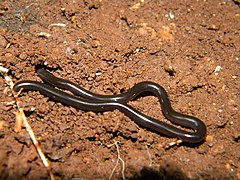Epictinae
| Epictinae[1] | |||
| Hedges, Adalsteinsson & Branch, 2009 | |||
 Przedstawiciel podrodziny – Epictia goudotii | |||
| Systematyka | |||
| Domena | |||
|---|---|---|---|
| Królestwo | |||
| Typ | |||
| Podtyp | |||
| Gromada | |||
| Podgromada | |||
| Rząd | |||
| Podrząd | |||
| Infrarząd | |||
| Nadrodzina | Typhlopoidea | ||
| Rodzina | |||
| Podrodzina | Epictinae | ||
| Typ nomenklatoryczny | |||
Epictia J.E. Gray, 1845 | |||
| Gatunki | |||
| |||
Epictinae – podrodzina węży z rodziny węży nitkowatych (Leptotyphlopidae).
Zasięg występowania
Podrodzina obejmuje gatunki występujące w Ameryce i Afryce[2][3].
Podział systematyczny
Do podrodziny należą następujące rodzaje[2]:
- Epictia
- Rena
- Rhinoguinea – jedynym przedstawicielem jest Rhinoguinea magna
- Rhinoleptus – jedynym przedstawicielem jest Rhinoleptus koniagui
- Siagonodon
- Tetracheilostoma
- Tricheilostoma
- Trilepida
Przypisy
- ↑ Epictinae, [w:] Integrated Taxonomic Information System [online] (ang.).
- ↑ a b P. Uetz & J. Hallermann: Higher taxa: Epictinae (ang.). The Reptile Database. [dostęp 2019-11-27].
- ↑ R. Midtgaard: Leptotyphlopidae (ang.). RepFocus. [dostęp 2019-11-27].
Media użyte na tej stronie
Autor: (of code) -xfi-, Licencja: CC BY-SA 3.0
The Wikispecies logo created by Zephram Stark based on a concept design by Jeremykemp.
Autor: Maximilian Paradiz from Merida, Mexico, Licencja: CC BY 2.0
Black Blind Snake (Leptotyphlops goudotii) Merida, Yucatan, Mexico
These small snakes spend most of their time underground, so they are rarely seen, although they are not rare. When their burrows get flooded, usually after heavy rains, they tend to come out and hide under the rocks.
